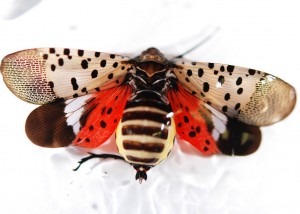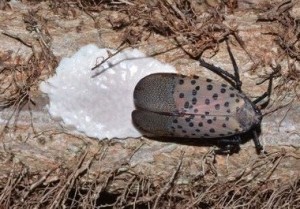 An unwelcome guest has recently been plaguing the plant life in Pennsylvania. These are nothing but Spotted Laternflies, which are beautiful, colourful insects and might seem like any other nuisance bug; but which are can prove to be extremely dangerous. The invasive pest poses a threat to fruit orchards and grape vines, along with forests and the timber industry. It attacks trees by feeding on sap and harms them further by excreting large amounts of a fluid that coats leaves and stems and encourages the growth of mold, according to researchers.
An unwelcome guest has recently been plaguing the plant life in Pennsylvania. These are nothing but Spotted Laternflies, which are beautiful, colourful insects and might seem like any other nuisance bug; but which are can prove to be extremely dangerous. The invasive pest poses a threat to fruit orchards and grape vines, along with forests and the timber industry. It attacks trees by feeding on sap and harms them further by excreting large amounts of a fluid that coats leaves and stems and encourages the growth of mold, according to researchers.
The Spotted Lanternfly is about one inch long and a half-inch wide, and is native to China, India, Japan and Vietnam. The insect uses its “piercing and sucking mouthparts” to drain stems of sap while at the same time excreting a lot of liquid. Due to the sugar content of the liquid, plant parts covered with spotted lanternfly excretion harbor mold growth, which could hinder plant growth. This can reduce photosynthesis, weaken the plant, and eventually contribute to the plant’s death. In addition, feeding can cause the plant to ooze or weep. It’s described as a weak flyer but a “strong and quick jumper,” and it’s done some serious damage in Korea, where it was introduced in 2006; it has since attacked some 25 plant species that can also be found in Pennsylvania. Spotted lanternfly feeds on a variety of host plants including fruit trees, ornamental trees, woody trees, and vines.
 This pest poses a significant threat to the state’s more than $20.5 million grape, nearly $134 million apple and more than $24 million stone fruit industries. Pine and hardwood logging in Pennsylvania also accounts for $12 billion in sales. The damage caused by this pest is so much so that around 5 Pennsylvania townships and 2 boroughs are on high alert after the state Department of Agriculture confirmed the presence of an invasive insect that threatens its grape vines, fruit trees and logging industry. To date, delimiting surveys conducted by the Pennsylvania Department of Agriculture (PDA) indicate that the infested area may be approximately 30 square kilometers (11.6 square miles) in six townships and two municipalities in eastern Berks County.
This pest poses a significant threat to the state’s more than $20.5 million grape, nearly $134 million apple and more than $24 million stone fruit industries. Pine and hardwood logging in Pennsylvania also accounts for $12 billion in sales. The damage caused by this pest is so much so that around 5 Pennsylvania townships and 2 boroughs are on high alert after the state Department of Agriculture confirmed the presence of an invasive insect that threatens its grape vines, fruit trees and logging industry. To date, delimiting surveys conducted by the Pennsylvania Department of Agriculture (PDA) indicate that the infested area may be approximately 30 square kilometers (11.6 square miles) in six townships and two municipalities in eastern Berks County.
The below article would aptly describe the threat posed by these pesky insects.
Invasive insect found in Berks County feeds on fruit, ornamental, woody trees
By Vincent Cotrone
November 16, 2014
The first American chestnut disappeared from our forests and landscapes in the early 1900s when an exotic fungal disease, cryphonectria parasitica, aka chestnut blight, was accidentally introduced.
Next it was American elms that we lost to an imported disease in the 1960s. More recently, we have seen imported insects such as Emerald Ash Borer killing millions of native ash trees across the Eastern United States, Hemlock Woolly Adelgid, a tiny aphid like insect, causing major declines in native hemlock, and Asian Longhorned Beetles threatening maples in New York and New England.
“When will it end?” you might ask yourself. Apparently not anytime soon, because a new invasive insect (a planthopper) named the Spotted Lanternfly (Lycorma delicatula) has just been discovered in Berks County. This pest is native to China, India and Vietnam. It attacks and feeds on many host plants including fruit trees (apples, pears, plums), ornamental trees, woody trees and vines. Apples, birch, cherry, dogwood, grapes, lilac, maple, poplar, stone fruits and tree-of-heaven are among more than 70 species of hosts attacked by this pest.
Adults and nymphs feed on phloem tissues of foliage and young stems with their piercing and sucking mouthparts and excrete large quantities of liquid. Due to the sugar content of the liquid, plant parts covered with spotted lanternfly excretion harbor mold growth, which could hinder plant growth or even cause death.
Think this is just another nuisance bug? Think again. This pest poses a significant threat to the state’s more than $20.5 million grape, nearly $134 million apple and more than $24 million stone fruit industries. Pine and hardwood logging in Pennsylvania also accounts for $12 billion in sales.
As the state Department of Agriculture tries to control the spread of this new pest by placing quarantines on the movement of plants, wood and stone materials out of Berks County, it will also be conducting surveys across the commonwealth to determine if the infestation is wide spread. This is where the home gardener and commercial landscaper or arborist comes in.
A research paper about the bug’s spread in Korea explains why it can be tough to control: “Furthermore, no natural enemy of L. delicatula seems to exist in Korea. Thus, farmers use pesticides to control them in vineyards (Park et al. 2009). However, the use of pesticides kills natural enemies of other grape pests and L. delicatula can repopulate pesticide-sprayed areas from nearby forested areas, which contain suitable host species.” Evidently, we need a solution which would prevent the spread of these insects, but at the same time not harm the beneficial pests in any way.
C Tech Corporation can offer a solution to overcome this problem. Our product Combirepel™ is an extremely low toxicity and extremely low hazard and eco-friendly rodent aversive. Combirepel™ is available in the form of solid masterbatches, liquid concentrate and in lacquer form. The product is compliant with RoHS, RoHS2, and REACH and is FIFRA exempted. This product acts through a series of highly developed intricate mechanism ensuring that rodents are kept away from the target application.
The fencing and tree guards can be coated withCombirepel™ to protect the trees, shrubs etc. from the damage caused by the grey squirrels. The product can also be incorporated into agricultural films, greenhouse films, plastic mulches used on a large scale in the agriculture as well as horticulture sector in order to avoid damages caused by these squirrels to fruits and vegetables. Also, the products can be directly incorporated in the polymer matrix during processing of pipes and tubing. Combirepel™ does not leach out, thus there is no soil pollution. Groundwater reserves are also not polluted. Also the non-target beneficial species like earthworms, bees etc are not affected.
The product is compliant with ROHS, ROHS2, ISO, REACH, APVMA, NEA, EU-BPR, and FIFRA exempted.
Contact us at technical.marketing@ctechcorporation.com if you’re facing problems with rodents and get best remedies to combat the pest menace.
Also, visit our websites:
http://www.ctechcorporation.com/
http://www.rodrepel.com/
http://www.termirepel.com/
http://www.combirepel.com/
Follow our Facebook pages at:
1] https://www.facebook.com/Combirepel-411710912249274/
2] https://www.facebook.com/Termirepel-104225413091251/
3] https://www.facebook.com/Rodrepel-120734974768048/
Follow us on our Twitter pages at:
1] https://twitter.com/rodrepel
2] https://twitter.com/termirepel
3] https://twitter.com/combirepel

